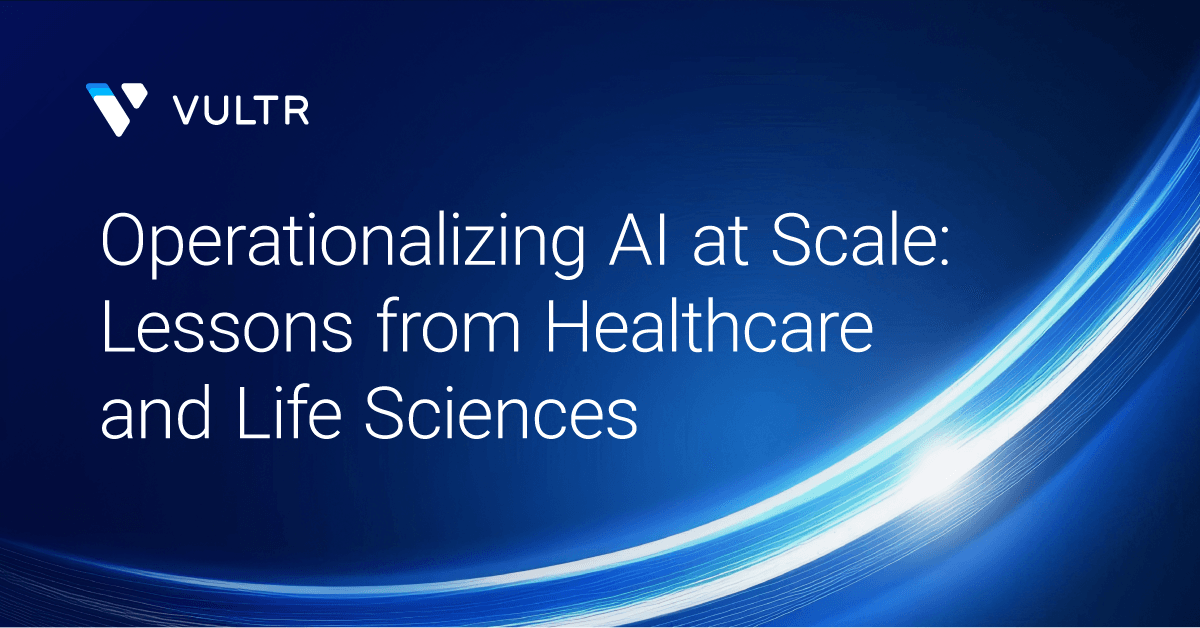AI is advancing rapidly across every industry, but nowhere is that evolution more mission-critical than in healthcare and life sciences. S&P Global Market Intelligence, in collaboration with Vultr, recently released its second annual global survey on AI maturity levels. While the global benchmark report highlights broad trends across industries, deeper analysis of healthcare and life sciences data reveals that these sectors lead the field in embedding AI into core operations.
But high maturity doesn’t mean a uniform trajectory. While healthcare and life sciences share common challenges such as compute constraints, data locality, and infrastructure gaps, they’re building toward operational AI under vastly different conditions. One is shaped by clinical urgency and real-time performance demands; the other by scientific rigor, long-cycle development, and reproducibility.
The survey reveals that scaling AI in these industries isn’t about developing better models. It’s about building the systems — technical, procedural, and organizational — that allow AI to perform reliably in high-stakes environments. And while the destinations may be similar, the path each sector takes must reflect its unique realities.
For a deeper look at how the healthcare sector is evolving, read the full industry-level findings in the Operationalizing AI in Healthcare: 2025 Benchmark Report and the Operationalizing AI in Life Sciences: 2025 Benchmark Report.
AI maturity on paper: A shared starting point
In the survey, AI leaders across healthcare and life sciences outpaced many of their cross-industry peers. Forty-three percent said their organizations had reached the highest tier of AI maturity, what the study defines as “Transformational.” At this stage, AI is embedded into core workflows, supported by dedicated governance structures, cross-functional teams, and long-term investment strategies. By comparison, less than 35% of respondents across all industries reported the same level of maturity.
Yet even as healthcare and life sciences lead the charge, they share a clear-eyed view of the challenges still ahead. Respondents highlighted several common roadblocks to real-time AI performance:
- Compute resources are inadequate to support real-time inferencing (58%)
- Storage connectivity (53%) and capacity (46%) are limiting performance
- Data locality issues inhibit real-time responsiveness (44%)
These challenges point to a larger truth: As important as model sophistication is for successful AI implementation, supporting those models with the right systems is just as — or even more — critical. And that’s where the paths of healthcare and life sciences begin to diverge.
Beneath the surface: Diverging sector realities
Healthcare and life sciences may face the same systemic barriers to real-time AI performance, but the nature of their operations shapes how those barriers show up in practice.
In healthcare, AI is often expected to deliver insights in the moment: during patient intake, in the middle of a clinical workflow, or as part of real-time diagnostics. That requires not just robust models, but low-latency infrastructure and seamless integration with existing electronic health record (EHR) systems, imaging platforms, and care coordination tools. When compute falls short or data isn’t immediately accessible, patient safety and clinician trust are at risk. The operational threshold for failure is low, and the tolerance for lag is even lower.
In life sciences, by contrast, AI is more often used to accelerate scientific exploration: identifying drug targets, modeling biological interactions, or analyzing experimental results. These applications still demand powerful infrastructure, but they’re governed by different pressures. Data integrity, traceability, and compliance take precedence over immediacy. Latency might not jeopardize lives in the moment—but gaps in lineage or reproducibility can derail entire programs. AI must be embedded in pipelines that meet strict validation standards and accommodate long-cycle R&D workflows.
In both cases, the need is the same: AI systems that work reliably in highly constrained, high-stakes environments. But how those systems are prioritized and implemented varies with the operational context of each sector.
Building for what comes next
Despite clear signs of maturity, healthcare and life sciences organizations are not rushing headlong into AI expansion. Instead, they’re laying careful groundwork for long-term scalability by prioritizing infrastructure flexibility, operational control, and sustainable investment.
Most organizations are allocating between 11% and 30% of their IT budgets to AI, with a projected average increase of 15% in the coming year. This measured growth reflects the realities of operating in regulated, resource-constrained environments where every investment must be justified by real-world readiness.
That pragmatism is also shaping infrastructure choices. Rather than centralizing on a single cloud provider, many organizations are distributing their workloads across a mix of alternative cloud platforms, hyperscalers, and internal data centers. Inference workloads, in particular, are diversifying: 32% are expected to run in third-party or alternative clouds, 23% on hyperscalers, and 20% in internal enterprise environments. This balance enables greater control over compliance, cost, and performance, especially for latency-sensitive or patient-facing applications.
Model strategy tells a similar story. A majority of organizations (53%) are adapting open source models rather than building from scratch or relying solely on commercial platforms. This approach supports agility and customization while preserving security and regulatory alignment.
Across both sectors, the signal is clear: AI maturity is shifting from conceptual ambition to operational design. The next phase isn’t about scaling fast; it’s about scaling right.
From maturity to momentum
High AI maturity may signal readiness, but it doesn’t guarantee results. For healthcare and life sciences, progress depends on turning embedded AI capabilities into scalable, production-grade systems through thoughtful alignment between technology, operations, and organizational strategy.
The organizations that succeed from here will be the ones that build deliberately: investing with purpose, maintaining agility while ensuring control, and scaling systems that reflect the real-world demands of their environments. In these sectors, AI must function within critical workflows and support decisions that improve lives and outcomes.
System design isn’t a downstream concern. It’s the operating blueprint for responsible, sustainable AI at scale. For a detailed dive into healthcare-specific strategies and infrastructure trends, explore the complete 2025 Operationalizing AI in Healthcare and Operationalizing AI in Life Sciences benchmark reports.

